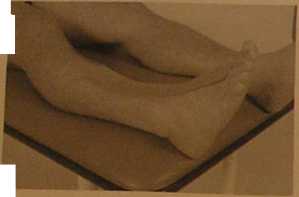P5140019
Functional Correction Application Technigno
Use of functional correction techniąue to assist or restrict a motion (e.g. flexion or extension). It is believed this is accomplished by changing the perception of joint position i through increased tension in the skin. The body will adjust joint position to normalize j| the increased tension on the skin in an attempt to return to normal tension leyels.


The Kinesio Tex Tape is applied by cutting i the appropriate length of an "I" Strip. Lengttt I shouldbeapproximately fourinchesabove ■ and below the joint (or a length appropriate,* for the joint chosen).
II
Place the joint or muscle to be taPe the appropriate position. Example- J * ing dorsiflexion and resisting plantar flexiOf. place the joint in dorsi flexion. g1*1 aP® application at the distal end of selected joint with a minimum of two inches of tape with io tension.

Apply an appropriate degree of tension from light to fuli and adhere the second base of the tape at the proximal end of the selected joint Initially it may be difficult to determine the appropriate amount of tension, severaJ applications may be needed prior to establishing proper tension. This base should also be a minimum of two inches of tape with no tension.
With one hand placed on each base, both proximal and distal, ha ve the patient actively move the joint into the opposite rangę of motion position. Example: if assisting dorsi-flexion and resisting plantar flexionhavethe patient now actively move into plantar flexion.
To finish the tape application moveboth hands towards the middle of the joint and apply remaining tape. Make surę to activate the acrylic adhesive prior to releasing tension, otherwise the Kinesio Strip willhave limited adherence.
Wyszukiwarka
Podobne podstrony:
Goodman, G. S., & Aman, C. (1990a). Children s use of anatomically detailed dolls to recount an
110 Sebastian Bobowski. Marcin Haberla • use of treatment not available at home or at better prices
TEACHER S USE OF ENGUSH AND POUSH Observe two or three lessons, notę down examples of teacher s use
The goals of Design Survey are to (1) provide an introductory knowledge of design in order to assist
nt netclient NetWork Client Administrator Use the NetWork Client Administrator to install or update
P5140018 Functional CorrectionTendon Correction Application Technigue Use of tendon correction techn
P5140006 Table of Contents Introduction Corrective Application Techniques Mechanical Correction
P5140007 INTRODUCTFON The Corrective Application Techniques are a continuation in the development of
P5140012 Mechanical Correction Application Technigues Application of Y Technigue Application of Y Te
Replication of current_user() The foliowing statements support use of the CURRENTJJSER () [1287] fun
CDR500 5 R-DS s^/iu Use of the RDS Function What is RDS? RadioDataSystem RDS is a serYice of the pu
P5140014 Fascła Correction Application Techniąue Useof faseta correction technigue to reposition fas
P5140016 Space Correction Application Tectinigii^g Fascia Corrections used for Space Correction Addi
P5140080 Hamstring Strain Combination Technique Combination of thc Kinesio Taping Technique and use
years after a correctly performed operation and the correct use of the implant. For this reason, mor
więcej podobnych podstron